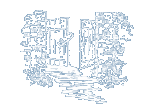|
|
|
|
|
|
|
|
|
|
|
|
|
|
|
|
|
|
|
|
|
|
|
|
|
|
|
|
|
|
|
|
|
|
|
|
|
|
|
|
|
|
|
|
|
|
|
|
|
|
|
|
|
|
|
|
|
|
|
|
|
How To Make the Lubbock Ant-Nest
|
|
|
|
|
|
|
|
|
|
|
|
|
|
|
|
|
|
|

|
|
How To Make the Lubbock Ant-Nest
Lesson XCVI
Material—Two pieces of window glass, 10 inches square; a sheet of tin,
11 inches square; a piece of plank, 1 ¼ inch thick, 20 inches long and at
least 16 inches wide; a sheet of tin or a thin, flat board, 10 inches square.
To make the nest—Take the plank and on the upper side, a short
distance from the edge, cut a deep furrow. This furrow is to be filled with
water, as a moat, to keep the ants imprisoned. It is necessary, therefore,
that the plank should have no knot holes, and that it be painted
thoroughly to keep it from checking. Take the sheet of tin 11 inches square,
and make it into a tray by turning up the edges three-eighths of an inch.
Place this tray in the middle of the plank. Place within the tray one
pane of glass. Lay around the edges of this glass four strips of wood
about half an inch wide and a little thicker than the height of the ants
which are to live in the nest. Cover the glass with a thin layer of fine
earth. Take the remaining pane of glass and cut a triangular piece off
of one corner, then place the pane on top of the other, resting upon the
pieces of wood around the sides. The cover of the nest may be a piece of
tin, with a handle soldered to the center, or a board with a screw-eye in the
center with which to lift it. There should be a piece of blotter or of very
thin sponge, introduced into the nest between the two panes of glass, in a
position where it may be reached with a pipette, without removing the
upper glass, for it must be kept always damp.
To establish a colony in this nest proceed as follows: Take a
two-quart glass fruit jar and a garden trowel. Armed with these, visit some
pasture or meadow near by, and find under some stone, a small colony of
ants which have plenty of eggs and larvæ. Scoop up carefully eggs, ants,
dirt and all and place in the jar, being as careful as possible not to injure
the specimens. While digging, search carefully for the queen, which is a
larger ant and is sometimes thus found. But if you have plenty of eggs,
larvæ and pupæ, the ants will become very contented in their new nest
while taking care of them. After you have taken all the ants desirable,
place the cover on the jar, carry them to the Lubbock nest and carefully
empty the contents of the fruit jar on top of the board which covers the
nest. Of course the furrow around the plank has been filled with water,
so the stragglers cannot escape. The ants will soon find the way into the
nest through the cut corner of the upper pane of glass, and will transfer
their larvæ to it because it is dark. After they are in the nest, which
should be within two or three hours, remove the dirt on the cover, and the
nest is ready for observation. But, since light disturbs the little prisoners,
the cover should be removed only for short periods.
The Fielde nest is better adapted for a serious study of ants, but it is
not so well adapted for the schoolroom as is the Lubbock nest.
Reference—Ants, W. M. Wheeler.
![[Illustration]](http://www.gatewaytotheclassics.com/bronze/books/comstock/insects/comstock_insects_zpage424.gif)
A Lubbock ant-nest.
|
|








![[Illustration]](http://www.gatewaytotheclassics.com/bronze/books/comstock/insects/comstock_insects_zpage424.gif)



